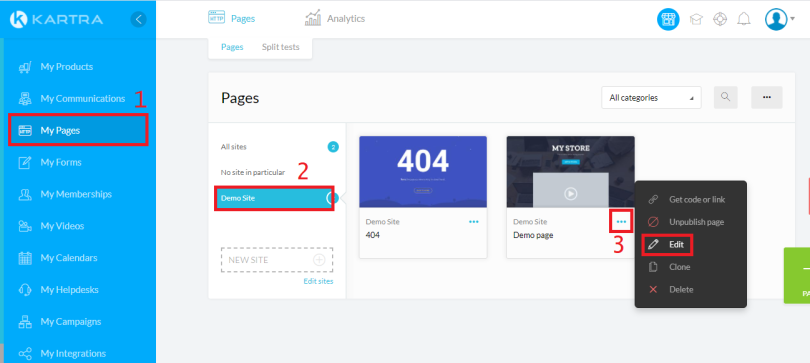Why Funnel Software Matters for Your Business Growth
Funnel software helps businesses automate and optimize the customer journey from first contact to final purchase. It combines landing pages, email marketing, payment processing, and analytics into a single system that converts visitors into customers.
Quick Answer: What to Look for in Funnel Software
- All-in-One Platforms: Best for entrepreneurs who want funnels, email, courses, and CRM in one place.
- Funnel-Specific Builders: Powerful for creating sales funnels but require separate tools for other features.
- Email Platforms with Funnels: Good if email marketing is your primary focus with basic funnel needs.
- CRM-Based Solutions: Ideal for B2B sales teams who prioritize lead management and sales pipeline tracking.
One entrepreneur noted their business was “100% looking in the rear-view mirror” before adopting funnel software. Now, they’re “looking out the front window” with real-time insights that drive decisions.
Every business needs a reliable way to convert leads into customers. Without funnel software, you’re piecing together multiple tools and guessing what works. With it, you automate follow-ups, personalize experiences, and see exactly where prospects drop off.
The numbers tell the story. Companies using funnel software report 4x higher lead-to-sales conversion rates, 35% time saved on routine tasks, and 15x higher conversion rates compared to manual processes. With hundreds of options available, choosing the right platform can feel overwhelming. Some platforms excel at everything, while others shine in specific areas. The wrong choice means wasted money and missed sales.
This guide breaks down what actually matters. We’ll compare the major types of funnel software, show you which features drive results, and help you match the right tool to your specific business model.
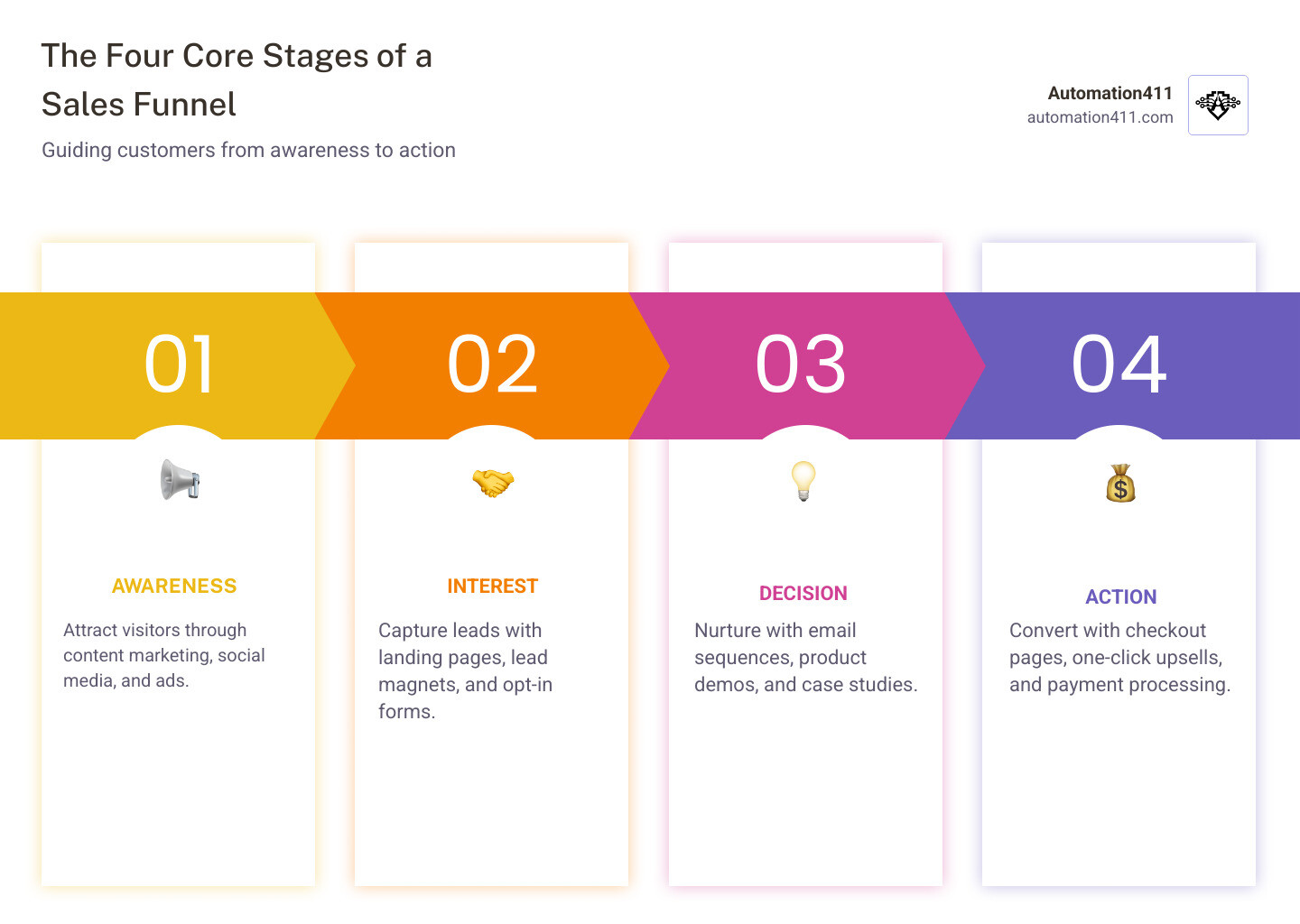
Funnel software glossary:
What is Funnel Software?
At its heart, a sales funnel is a visual representation of the customer’s journey, from awareness to purchase. Funnel software is the digital toolkit that helps you build, manage, and optimize this journey. It’s designed to streamline and automate the process of moving potential customers through various stages – typically Awareness, Interest, Decision, and Action.
This transforms a complex customer journey into a predictable and scalable process. Instead of hoping for sales, you can design a system that actively guides prospects towards conversion.
Funnel software plays a critical role in:
- Lead Generation: Attracting customers through landing pages and opt-in forms.
- Lead Nurturing: Building relationships through automated email sequences and targeted messaging.
- Conversion Optimization: Guiding leads to purchase through compelling offers and seamless checkouts.
By providing the necessary data and organizational features, funnel software turns a business-critical process into something repeatable and scalable. It’s a growth tool that fuels efficiency, with some users reporting a 35% task time saved for teams and processing leads 4 times faster. It empowers data-driven decisions, moving businesses away from guesswork and towards strategies backed by real insights.
Core Features to Look For in Funnel Platforms
When shopping for funnel software, you don’t need every bell and whistle. You need the right tools that actually move the needle. Think of each feature as playing a specific role in helping you attract, nurture, and convert customers.
-
Visual Funnel Mapper: This is your blueprint of the customer journey. A good mapper lets you visualize how leads move through your funnel, spot bottlenecks, and map out automated sequences before you launch.
-
Drag-and-Drop Editor: You’ll want an intuitive editor for building landing pages, emails, and forms without code. The best editors let you grab elements, drop them where you want, and adjust until it looks perfect.
-
Pre-built Templates & Campaigns: Why start from scratch? The best platforms offer conversion-optimized templates and entire campaign blueprints—landing pages, email sequences, and checkout pages—that you can customize and launch quickly.
-
Landing Page Builder: This is where you make your first impression. The builder should be mobile-responsive, load fast, and integrate seamlessly with your editor. A slow page can kill your conversion rate.
-
A/B Split Testing: This is your secret weapon for optimization. Create two versions of a page or email, send traffic to each, and let the data tell you which performs better. Companies that test consistently see dramatically better results, with some reporting 15x higher conversion rates.
-
Email Marketing Automation: This does the heavy lifting. Set up sequences that trigger based on actions like downloading a lead magnet or abandoning a cart. It all happens automatically.
-
Sequence Builder: The best sequence builders give you a visual timeline to orchestrate your automated flows. You can add delays, create branches based on behavior, and adjust the journey until it feels natural.
-
Built-in Checkout & Payment Integration: You need a smooth, professional checkout process that inspires confidence. This means no clunky redirects and secure integration with services like Stripe and PayPal.
-
Real-Time Analytics & Reporting: You need dashboards that show what’s happening right now—traffic, conversion rates, sales, and customer behavior. The best platforms make this data visual and easy to understand.
-
Lead Management & CRM Capabilities: As your list grows, you need to stay organized. Segment contacts, tag them by behavior, and score them by engagement. Built-in CRM features mean you’re not just collecting leads—you’re building relationships by tracking every interaction and automating follow-ups.
When these features work together in a single platform, your marketing becomes a system instead of a scramble.
The Importance of an All-in-One Solution
Using five different tools for your sales funnel feels like trying to cook a meal with your kitchen scattered across town. This is where all-in-one funnel software changes everything.
The beauty of an all-in-one solution is seamless integration. Everything is designed to work together from day one. Your landing pages connect to your email sequences, which trigger based on checkout behavior. Your analytics track the entire journey without gaps. No wrestling with APIs or hiring developers to fix broken connections.
This creates unified customer data. Every interaction a lead has with your business lives in one place, giving you a complete picture of each person. You can personalize your messaging based on their actual behavior, not just a guess.
Let’s talk cost-effectiveness. An all-in-one platform might seem pricier at first, but add up the costs of separate tools: email, landing pages, checkout, CRM, and the connectors that tie them together. An all-in-one solution often costs less than that Frankenstein setup and includes more features. You’re eliminating third-party tools and the headaches that come with them.
As your business grows, scalability becomes your best friend. All-in-one platforms are built to grow with you, handling more traffic, leads, and complexity without forcing you to rebuild your tech stack. Research shows that integrated platforms deliver 50x faster implementation times, 15x higher conversion rates, and 5x more qualified leads compared to pieced-together systems.
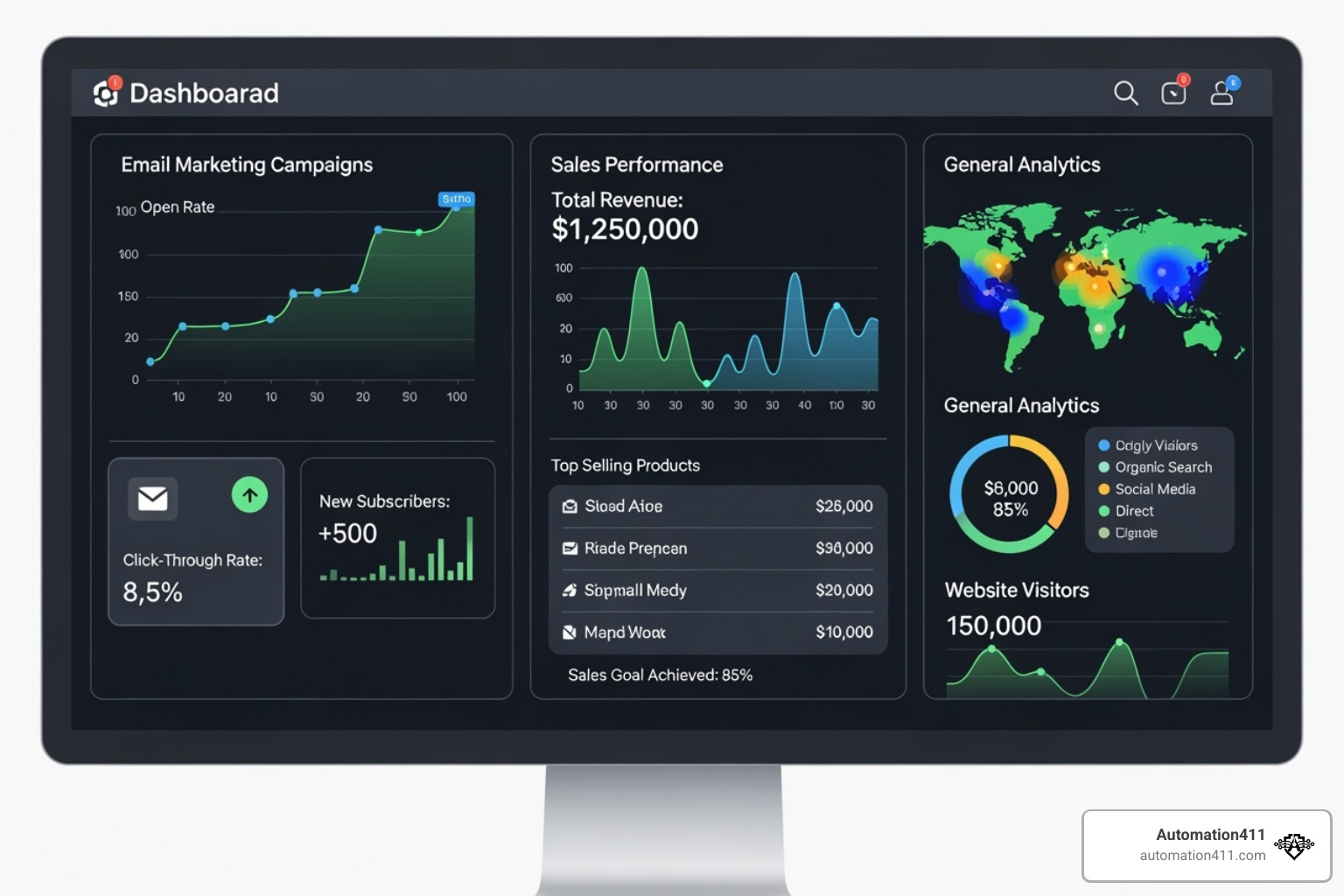
Your customers have a better, more cohesive experience, which builds trust. You’re not just saving time and money; you’re building a foundation that supports growth instead of creating more work.
Types of Funnel Tools: All-in-One vs. Modular Approaches
When shopping for funnel software, it’s like walking into a home improvement store. Some need a complete workshop, while others just need a really good saw. The funnel software market mirrors this. There’s no single “best” solution because every business has different needs.
Let’s walk through the main categories to figure out which approach fits best.
| Category | Feature Set | Integration Needs | Cost | Scalability |
|---|---|---|---|---|
| All-in-One Platforms | Comprehensive (funnels, email, CRM, courses, payments) | Minimal, everything is native | Can be higher initial, but cost-effective long-term | Excellent, built for growth |
| Modular Funnel Builders | Deep funnel-building, landing pages, checkout | High, needs external email, CRM, analytics | Variable, can get expensive piecing together | Good for funnels, but overall scalability depends on integrations |
| Email Platforms with Funnel Improvements | Email marketing, basic landing pages, simple automation | Moderate, might need separate checkout, advanced analytics | Generally lower, based on subscriber count | Good for email-centric businesses, limited for complex funnels |
| CRM-Based Funnel Solutions | CRM, lead management, sales pipeline, basic marketing | Moderate, might need external builders for advanced funnels | Variable, often tiered by users/features | Excellent for sales teams, marketing features can be less advanced |
All-in-One Marketing Platforms
Think of all-in-one platforms as the Swiss Army knife of marketing. These comprehensive suites include everything you need to run an online business from a single dashboard: sales funnel builders, email marketing automation, a full CRM, website builders, e-commerce capabilities, course and membership hosting, and affiliate management.
The beauty is that everything talks to each other natively. No complicated integrations or data living in five different places. It’s all in one unified system—a single source of truth. This makes them incredibly powerful for e-commerce, SaaS, content creators, and B2B service providers.
Kartra, for instance, is built as a comprehensive platform with a robust sales funnel builder that minimizes the need for external integrations. The cost-effectiveness shows up over time. While the monthly price might seem higher, it’s often less than paying for multiple separate tools.
The main challenge can be a learning curve, but you don’t need to master every feature on day one. You can start with the basics and grow into the platform.
Modular Funnel Builders
Some tools are laser-focused on one thing: building sales funnels and landing pages. These modular builders are the specialists of the funnel software world, often delivering incredibly intuitive funnel-building experiences.
The trade-off is that you’ll need to connect other tools for email marketing, CRM, or advanced analytics. This means managing multiple subscriptions and dealing with integrations that can break. Costs can also creep up as you add more tools, sometimes exceeding the price of an all-in-one solution.
However, if you already have an email and CRM system you love, adding a specialized funnel builder might be exactly what you need.
Email Platforms with Funnel Improvements
Many email marketing platforms have added basic funnel software features. For bloggers or small businesses where email is the heart of the marketing strategy, these can be a smart starting point. The interface feels familiar, and they can handle most simple sales funnel functions independently.
The limitation is that they are email platforms first. They typically offer simpler landing page builders and more basic automation compared to dedicated funnel builders or all-in-one platforms. They work beautifully for straightforward workflows but may be outgrown as a business becomes more sophisticated.
CRM-Based Funnel Solutions
Some platforms started as CRM systems and later added marketing and funnel capabilities. These platforms shine for businesses where sales process tracking and lead management are paramount, especially in B2B environments. They excel at contact management, deal tracking, and detailed sales analytics.
For sales teams that need to see exactly where each lead sits in the pipeline, these CRM-based solutions are incredibly powerful. The flip side is that their marketing and page-building features can sometimes feel less advanced, potentially requiring additional tools for highly customized funnels. For B2B service businesses, this trade-off often makes sense.
How to Choose the Right Funnel Software for Your Business
Choosing the right funnel software is about understanding what you actually need, not what sounds impressive in a sales pitch.
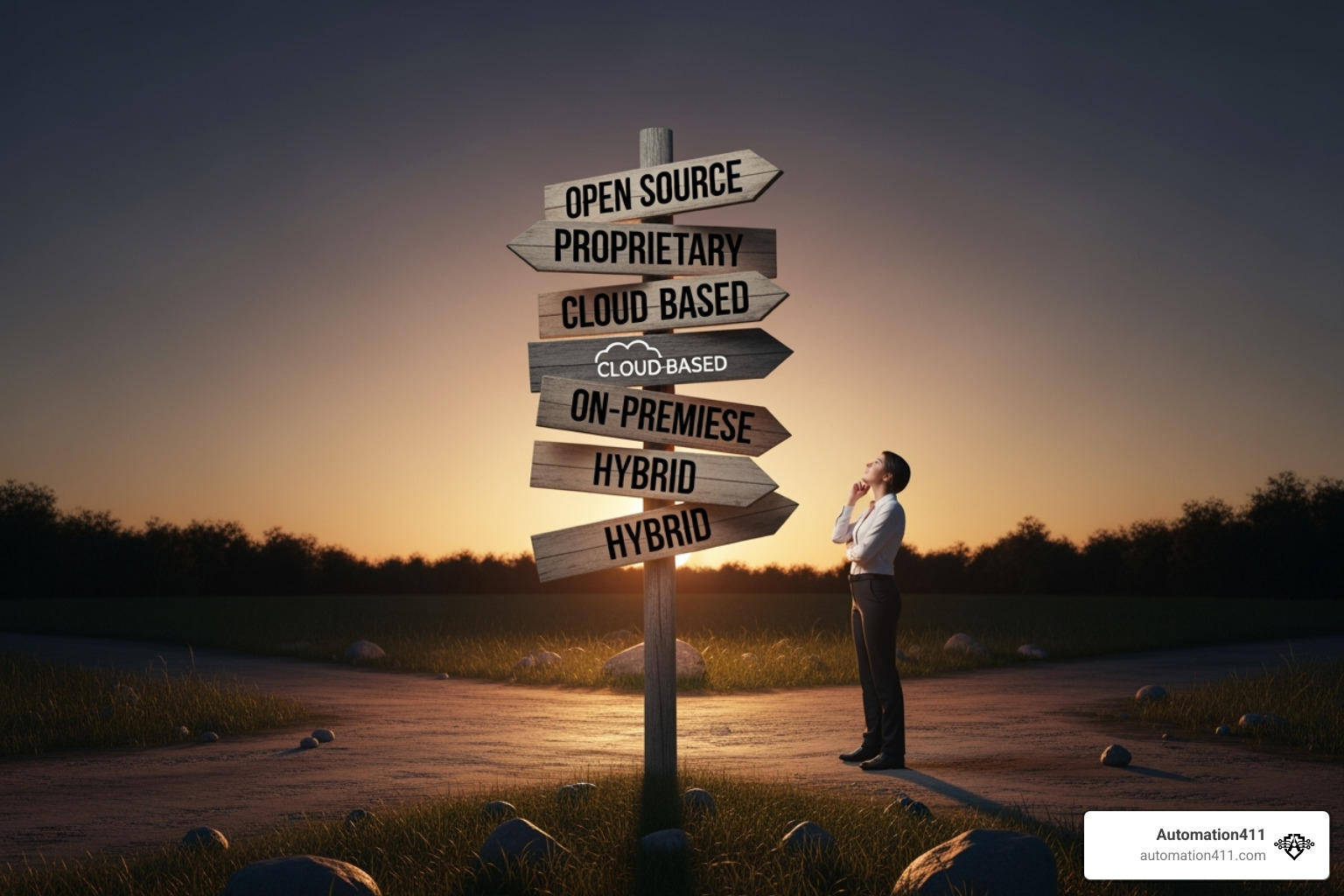
-
Business Needs Assessment: Start by defining your goals. Are you launching a course, growing an e-commerce store, or generating B2B leads? Your current and future goals should drive your decision.
-
Budget Considerations: Think beyond the monthly subscription. Factor in hidden costs like transaction fees and the value of your time spent managing integrations versus building your business.
-
Pricing Models: Understand how platforms charge. Some are based on contacts, others on features. A cheap starting plan might become expensive as you grow, so check the pricing tiers.
-
Ease of Use: A tool is worthless if you can’t use it. Look for intuitive drag-and-drop editors that let you focus on your customers, not on learning complex software.
-
Integration Capabilities: Even all-in-one platforms may need to connect with other tools you use, like accounting or webinar software. Ensure your chosen platform plays nicely with your existing tech stack.
-
Scalability: The platform that’s perfect today needs to grow with you tomorrow. Look for solutions that can handle more traffic, products, and automation without forcing you to migrate systems later.
Matching Features to Your Business Model
The “best” funnel software is the one that matches what you’re actually doing.
-
E-commerce: You need solid checkout pages, one-click upsells, and abandoned cart recovery. Inventory and shipping integrations are also key.
-
SaaS Businesses: Focus on converting free trials to paid plans. Your onboarding sequences and customer success automation are critical for retention.
-
B2B Services: It’s all about lead qualification and pipeline management. You need detailed CRM features, appointment scheduling, and follow-up automation.
-
Content Creators: You need simple content delivery, whether for courses or memberships. Look for platforms with integrated course hosting, membership management, and email marketing. Kartra excels here, offering everything from course delivery to affiliate management in one platform.
-
Agencies: You’ll want client management features, white-label options, and the ability to keep client data separate.
-
Lead Generation: You need high-converting landing page builders and follow-up sequences that turn cold leads into warm prospects.
Understanding Pricing and Long-Term Value
The real cost of funnel software is about the value it delivers, not just the price tag.
-
Subscription Costs & Tiered Plans: Costs vary wildly. The question isn’t whether a platform is cheap, but whether it delivers value. Understand the pricing tiers and what features open up as you pay more.
-
Free Tiers: These are great for testing a platform or starting on a tight budget, but be aware of their limitations, such as contact caps, branding watermarks, and restricted features.
-
Transaction Fees: Some platforms charge a percentage of each sale on top of your payment gateway fees. This can add up significantly as you grow.
-
Return on Investment (ROI): The real measure is ROI. A $200/month platform that increases conversions by 15% is a bargain. A $30/month tool that’s clunky and limits growth is expensive at any price.
-
Total Cost of Ownership: Factor in training time, integration costs, and the opportunity cost of choosing a platform that can’t scale. The right software pays for itself many times over through increased efficiency and revenue.
Optimizing Your Strategy with Advanced Funnel Features
Once you’ve chosen your funnel software, the real magic happens when you tap into its advanced features. Automation, analytics, and AI are the tools that separate businesses that just survive from those that truly thrive.
The Power of Automation in your Funnel Software
Automation is a secret weapon for any business. It handles repetitive tasks so you can focus on creating, serving customers, and building something meaningful. When someone downloads your lead magnet at 2 AM, automation ensures they get a welcome email instantly. This is what we mean by streamlining the sales process.
Your funnel software becomes a tireless team member. Leads get assigned automatically, follow-up reminders go out on schedule, and abandoned carts trigger recovery emails. It all just works.
The numbers are compelling. Businesses using automation see leads processed 4 times faster. Teams report saving 35% of their time on routine tasks. One company even documented $4-5 million in annual operational savings from automating its marketing and sales processes.
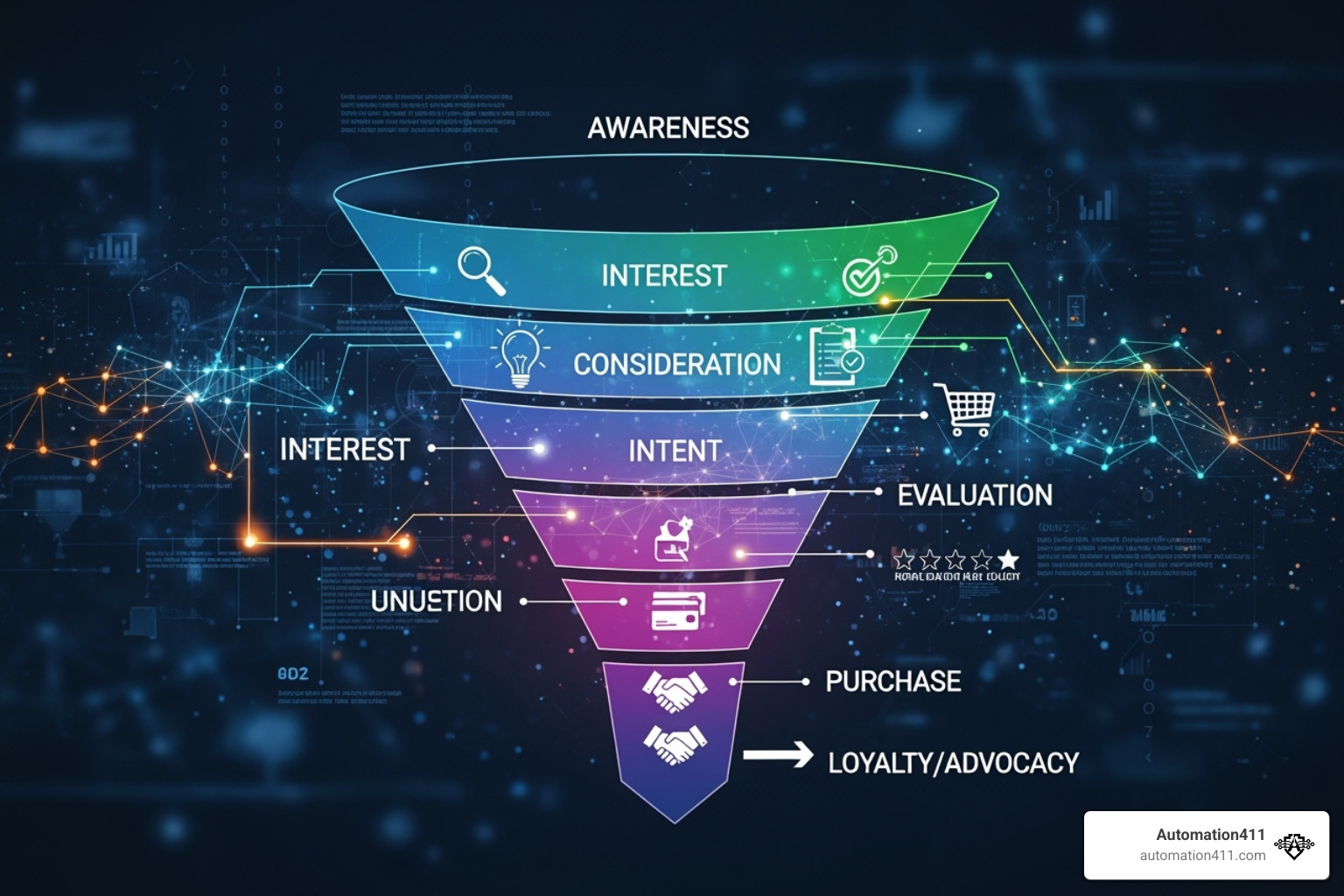
That saved time allows your team to focus on what matters: your sales team can have more conversations, your marketing team can strategize, and you can work on growing your business.
Leveraging Analytics for Data-Driven Decisions
Analytics puts you in the driver’s seat. It’s about getting clear answers to simple questions: Which landing page converts better? Where are people dropping off? What email subject line gets clicks?
With real-time funnel analytics, you can watch your business like you’re monitoring a heartbeat. You see traffic flowing in and can spot exactly where things get stuck. A/B testing becomes your laboratory for continuous improvement. Test two headlines, see which one wins, and let the data decide. Companies that accept this testing mindset report 15 times higher conversion rates.
You’re no longer making decisions based on hunches. When someone asks if you should invest more in Facebook or Google ads, you have the data to answer. Some businesses have seen a 26% increase in return on ad spend simply by making smarter decisions based on their analytics. This shift from gut-feeling to data-driven strategy is what separates businesses that plateau from those that scale.
The Future: AI and the Shift to the Flywheel Model
The landscape of funnel software is changing, driven by AI and a new way of thinking about the customer journey.
First, there’s AI. We’re talking about practical tools that make your marketing smarter. AI can help write compelling email copy, predict which leads are most likely to buy, and engage visitors 24/7 with chatbots. In some industries, AI assistants have boosted conversion rates by 33%. Some platforms now let you chat with an AI to build your funnels, like having a marketing expert on call.
Perhaps the bigger shift is from the traditional funnel model to the more sustainable flywheel model.
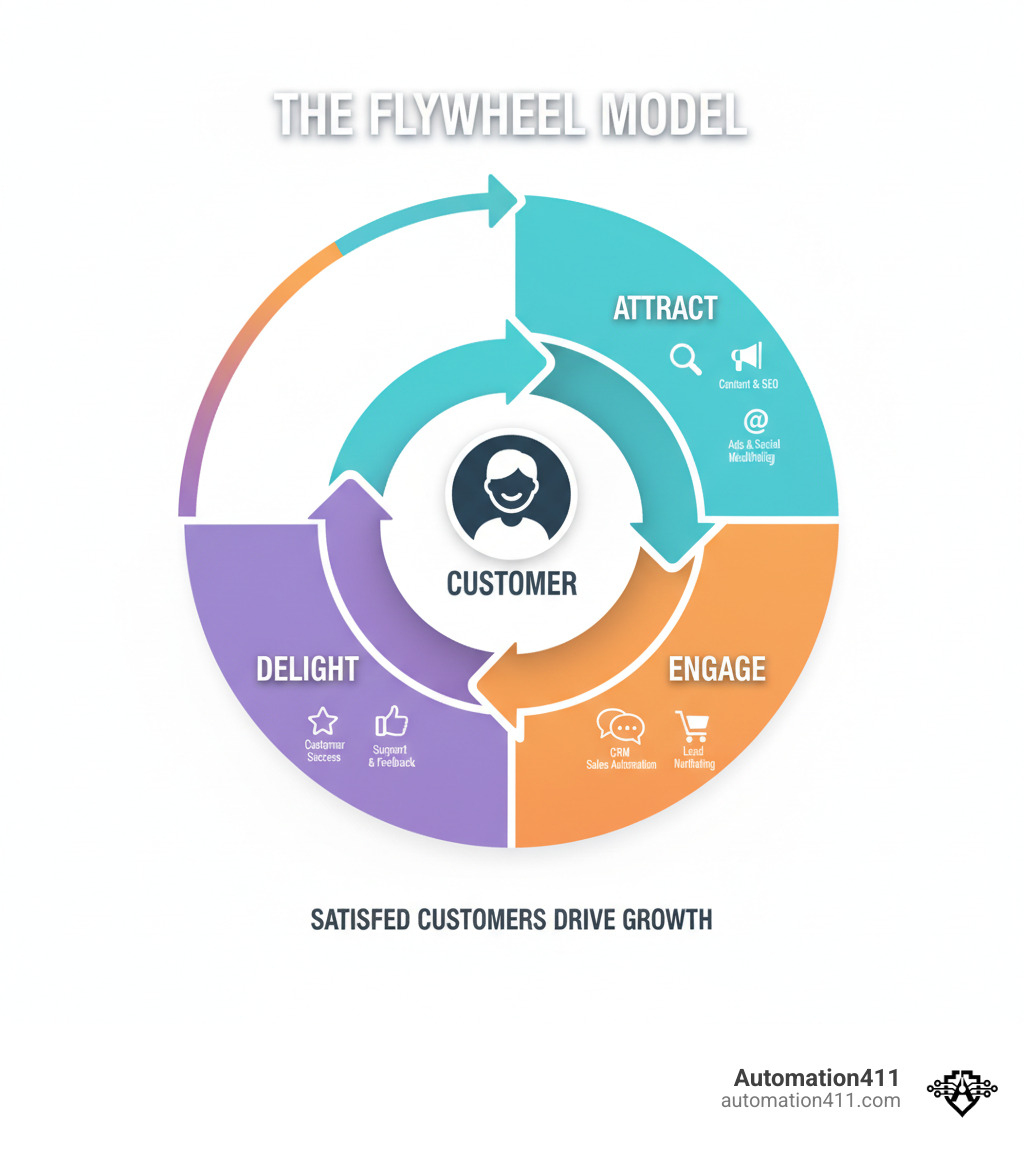
The old funnel model ends at the purchase. The flywheel model recognizes that your happiest customers become your best marketers. They leave reviews, refer friends, and buy again, fueling your growth. Modern funnel software focuses on customer retention with post-purchase sequences, membership portals, and personalized support. Companies that centralize these efforts report results like a 15% increase in customer retention year-over-year.
The businesses winning today are building systems that turn customers into loyal advocates who make the entire business flywheel spin faster.
Frequently Asked Questions about Funnel Software
Here are answers to some common queries about funnel software.
What’s the difference between a sales funnel and a sales pipeline?
While often used interchangeably, they represent different perspectives:
- Sales Funnel (Marketing Perspective): This visualizes the customer’s journey from awareness to purchase. It’s about guiding a broad audience through stages with content and offers.
- Sales Pipeline (Sales Perspective): This is an internal sales process that tracks specific deals through your sales team’s stages (e.g., Prospecting, Qualification, Closed-Won). It’s about managing individual opportunities.
Think of it this way: funnel software fills the sales pipeline with qualified leads.
Can I use free funnel software to start my business?
Absolutely. Many platforms offer free tiers or trials, making them a fantastic starting point. However, it’s important to understand the limitations:
- Feature & Contact Limits: Free plans often restrict access to advanced features and limit the number of contacts or emails.
- Branding: Some free plans include the software’s branding on your pages.
- Support: Customer support may be limited for free users.
Free funnel software is excellent for learning and validating ideas. As your business grows, you’ll likely need to upgrade to a paid plan to open up full functionality and scale your efforts.
How does this software improve customer retention?
While known for acquisition, funnel software is incredibly powerful for retaining customers:
- Automated Post-Purchase Sequences: We can set up automated emails after a purchase to offer support, tips, or complementary products, keeping customers engaged.
- Personalized Communication: By segmenting customers based on their purchase history, we can send highly relevant communications that strengthen their connection to our brand.
- Membership Sites & Communities: Many all-in-one platforms include tools for creating membership sites, which provide exclusive content and build loyalty.
- Feedback Loops: We can use surveys and forms to gather customer feedback and continuously improve their experience.
By consistently delivering value, funnel software helps foster genuine brand loyalty and turn customers into advocates, which is the essence of the ‘flywheel’ model.
Conclusion
Choosing the right funnel software isn’t just a tech decision; it’s the foundation for your business growth. We’ve seen how these platforms transform marketing chaos into a predictable, automated system. It’s the difference between looking in the rear-view mirror and seeing the road ahead clearly.
The evidence is compelling. Businesses using the right funnel software are seeing 4x higher lead-to-sales conversion rates and saving 35% of their time on routine tasks. They’re making decisions based on real data instead of gut feelings. These are game-changing improvements.
While specialized tools have their place, all-in-one platforms consistently emerge as the most comprehensive solution. They eliminate integration headaches, unify customer data, and are often more cost-effective than piecing together multiple subscriptions. When everything works together seamlessly, you can focus on serving your customers.
The future is already here. AI is making funnel software smarter, and the shift to the flywheel model reminds us that the sale is just the beginning of the relationship. The best platforms help you not just convert customers, but delight them into becoming your most powerful advocates.
The bottom line? The right funnel software builds a system for sustainable success that grows with you and keeps you competitive.
Ready to see what an all-in-one solution can do for your business? At Automation411, we don’t just talk about these platforms – we use them, test them, and teach others how to master them. We offer exclusive bonus training to help you get the most out of your funnel software investment. Explore our deep-dive reviews and tutorials on all-in-one marketing platforms and find how to build the automated business you’ve been dreaming about.

